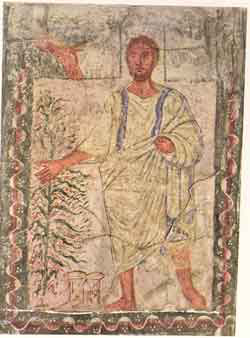Introduction
Who are the cherubim? Celestial winged beings, mentioned 90 times in the Hebrew Bible and once in the New Testament, their antecedent seems to be the exotic, composite beast known as lamassu in Assyria: partly ox, lion, eagle and human. These creatures served as mythic gatekeepers for gods and kings.
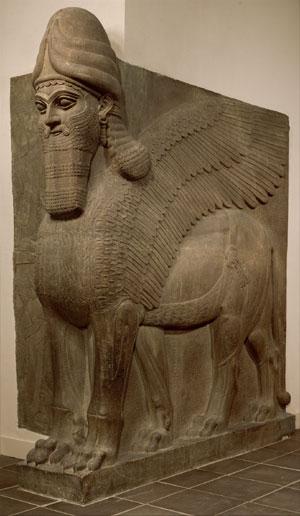
In the Bible, their description is fragmentary. Sometimes they are statues, carved reliefs, sometimes woven images and sometimes they are "living beings".
The cherubim first appear in Genesis 3:24, as fearsome, fiery guardians of the gates of Eden, barring the re-entrance of the humans. In art, they are often pictured as a single, sword-wielding agent of God, unceremoniously ejecting Adam and Eve out into the world.
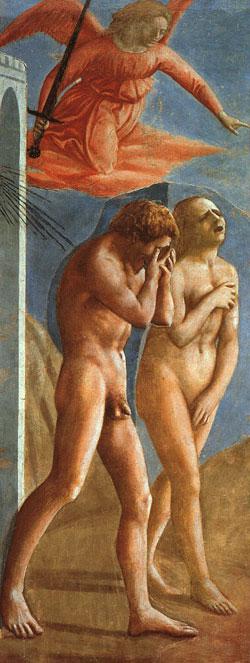
The Divine Throne
They turn up next in Exodus as a pair of solid gold winged statues, opposite each other on the cover (kaporet) of the Ark.
(י) וְעָשׂ֥וּ אֲר֖וֹן עֲצֵ֣י שִׁטִּ֑ים אַמָּתַ֨יִם וָחֵ֜צִי אׇרְכּ֗וֹ וְאַמָּ֤ה וָחֵ֙צִי֙ רׇחְבּ֔וֹ וְאַמָּ֥ה וָחֵ֖צִי קֹמָתֽוֹ׃ (יא) וְצִפִּיתָ֤ אֹתוֹ֙ זָהָ֣ב טָה֔וֹר מִבַּ֥יִת וּמִח֖וּץ תְּצַפֶּ֑נּוּ וְעָשִׂ֧יתָ עָלָ֛יו זֵ֥ר זָהָ֖ב סָבִֽיב׃ (יב) וְיָצַ֣קְתָּ לּ֗וֹ אַרְבַּע֙ טַבְּעֹ֣ת זָהָ֔ב וְנָ֣תַתָּ֔ה עַ֖ל אַרְבַּ֣ע פַּעֲמֹתָ֑יו וּשְׁתֵּ֣י טַבָּעֹ֗ת עַל־צַלְעוֹ֙ הָֽאֶחָ֔ת וּשְׁתֵּי֙ טַבָּעֹ֔ת עַל־צַלְע֖וֹ הַשֵּׁנִֽית׃ (יג) וְעָשִׂ֥יתָ בַדֵּ֖י עֲצֵ֣י שִׁטִּ֑ים וְצִפִּיתָ֥ אֹתָ֖ם זָהָֽב׃ (יד) וְהֵֽבֵאתָ֤ אֶת־הַבַּדִּים֙ בַּטַּבָּעֹ֔ת עַ֖ל צַלְעֹ֣ת הָאָרֹ֑ן לָשֵׂ֥את אֶת־הָאָרֹ֖ן בָּהֶֽם׃ (טו) בְּטַבְּעֹת֙ הָאָרֹ֔ן יִהְי֖וּ הַבַּדִּ֑ים לֹ֥א יָסֻ֖רוּ מִמֶּֽנּוּ׃ (טז) וְנָתַתָּ֖ אֶל־הָאָרֹ֑ן אֵ֚ת הָעֵדֻ֔ת אֲשֶׁ֥ר אֶתֵּ֖ן אֵלֶֽיךָ׃ (יז) וְעָשִׂ֥יתָ כַפֹּ֖רֶת זָהָ֣ב טָה֑וֹר אַמָּתַ֤יִם וָחֵ֙צִי֙ אׇרְכָּ֔הּ וְאַמָּ֥ה וָחֵ֖צִי רׇחְבָּֽהּ׃ (יח) וְעָשִׂ֛יתָ שְׁנַ֥יִם כְּרֻבִ֖ים זָהָ֑ב מִקְשָׁה֙ תַּעֲשֶׂ֣ה אֹתָ֔ם מִשְּׁנֵ֖י קְצ֥וֹת הַכַּפֹּֽרֶת׃ (יט) וַ֠עֲשֵׂ֠ה כְּר֨וּב אֶחָ֤ד מִקָּצָה֙ מִזֶּ֔ה וּכְרוּב־אֶחָ֥ד מִקָּצָ֖ה מִזֶּ֑ה מִן־הַכַּפֹּ֛רֶת תַּעֲשׂ֥וּ אֶת־הַכְּרֻבִ֖ים עַל־שְׁנֵ֥י קְצוֹתָֽיו׃ (כ) וְהָי֣וּ הַכְּרֻבִים֩ פֹּרְשֵׂ֨י כְנָפַ֜יִם לְמַ֗עְלָה סֹכְכִ֤ים בְּכַנְפֵיהֶם֙ עַל־הַכַּפֹּ֔רֶת וּפְנֵיהֶ֖ם אִ֣ישׁ אֶל־אָחִ֑יו אֶ֨ל־הַכַּפֹּ֔רֶת יִהְי֖וּ פְּנֵ֥י הַכְּרֻבִֽים׃ (כא) וְנָתַתָּ֧ אֶת־הַכַּפֹּ֛רֶת עַל־הָאָרֹ֖ן מִלְמָ֑עְלָה וְאֶל־הָ֣אָרֹ֔ן תִּתֵּן֙ אֶת־הָ֣עֵדֻ֔ת אֲשֶׁ֥ר אֶתֵּ֖ן אֵלֶֽיךָ׃ (כב) וְנוֹעַדְתִּ֣י לְךָ֮ שָׁם֒ וְדִבַּרְתִּ֨י אִתְּךָ֜ מֵעַ֣ל הַכַּפֹּ֗רֶת מִבֵּין֙ שְׁנֵ֣י הַכְּרֻבִ֔ים אֲשֶׁ֖ר עַל־אֲר֣וֹן הָעֵדֻ֑ת אֵ֣ת כׇּל־אֲשֶׁ֧ר אֲצַוֶּ֛ה אוֹתְךָ֖ אֶל־בְּנֵ֥י יִשְׂרָאֵֽל׃ {פ}
(10) They shall make an ark of acacia wood, two and a half cubits long, a cubit and a half wide, and a cubit and a half high. (11) Overlay it with pure gold—overlay it inside and out—and make upon it a gold molding round about. (12) Cast four gold rings for it, to be attached to its four feet, two rings on one of its side walls and two on the other. (13) Make poles of acacia wood and overlay them with gold; (14) then insert the poles into the rings on the side walls of the ark, for carrying the ark. (15) The poles shall remain in the rings of the ark: they shall not be removed from it. (16) And deposit in the Ark [the tablets of] the Pact which I will give you. (17) You shall make a cover of pure gold, two and a half cubits long and a cubit and a half wide. (18) Make two cherubim of gold—make them of hammered work—at the two ends of the cover. (19) Make one cherub at one end and the other cherub at the other end; of one piece with the cover shall you make the cherubim at its two ends. (20) The cherubim shall have their wings spread out above, shielding the cover with their wings. They shall confront each other, the faces of the cherubim being turned toward the cover. (21) Place the cover on top of the Ark, after depositing inside the Ark the Pact that I will give you. (22) There I will meet with you, and I will impart to you—from above the cover, from between the two cherubim that are on top of the Ark of the Pact—all that I will command you concerning the Israelite people.
Here, God speaks to Israel from above and between the facing cherubim; the tablets of the law are inside the box below. This complex iconography indicates that the cover and the cherubim are the flying throne of God and the rectangular box (the Ark) is God's footstool (hadom, Psalms 132:7; I Chronicles 28:2). From several Ancient Near Eastern texts we learn that law codes were deposited inside the king's footstool; similarly, the tablets of the Covenant are deposited in the ark. Since, in Israel, the Law superseded the Divine image as the focus of worship, the small footstool became the large rectangular container for the Tablets.
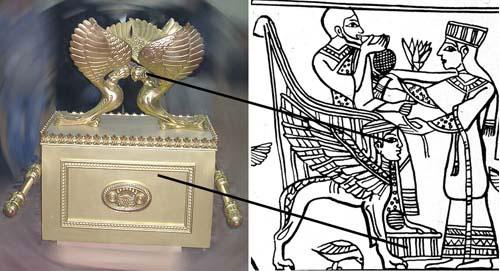
Reconstruction of the Ark The Cherub Throne
13 - 12th century BCE
The word cherub appears in Exodus an additional 19 times, but without additional description.
The Divine Chariot
The next narrative mention of the cherubim occurs in I Samuel 4, where the ark, brought to a battlefield, is described:
(ד) וַיִּשְׁלַ֤ח הָעָם֙ שִׁלֹ֔ה וַיִּשְׂא֣וּ מִשָּׁ֗ם אֵ֣ת אֲר֧וֹן בְּרִית־יְהֹוָ֛ה צְבָא֖וֹת יֹשֵׁ֣ב הַכְּרֻבִ֑ים וְשָׁ֞ם שְׁנֵ֣י בְנֵֽי־עֵלִ֗י עִם־אֲרוֹן֙ בְּרִ֣ית הָאֱלֹהִ֔ים חׇפְנִ֖י וּפִֽינְחָֽס׃
(4) So the troops sent men to Shiloh; there Eli’s two sons, Hophni and Phinehas, were in charge of the Ark of the Covenant of God, and they brought down from there the Ark of the Covenant of the LORD of Hosts Enthroned on the Cherubim.
The static cherubim take flight in II Samuel 22, parallel to Psalms 18, dramatically transporting God on "the wings of the wind".
(יא) וַיִּרְכַּ֥ב עַל־כְּר֖וּב וַיָּעֹ֑ף וַיֵּרָ֖א עַל־כַּנְפֵי־רֽוּחַ׃ (יב) וַיָּ֥שֶׁת חֹ֛שֶׁךְ סְבִיבֹתָ֖יו סֻכּ֑וֹת חַֽשְׁרַת־מַ֖יִם עָבֵ֥י שְׁחָקִֽים׃
(11) He mounted a cherub and flew;He was seen on the wings of the wind. (12) He made pavilions of darkness about Him,Dripping clouds, huge thunderheads;
Here the word cherub is parallel to and synonymous with cloud formations, thus imaging the celestial God riding the clouds, his vehicle personified as cherubim.
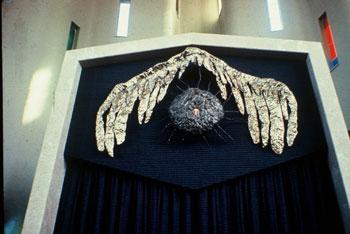
Ibram Lassaw, Torah Ark, Temple Anshe Hesed,
Cleveland, 1956
Perhaps the verbal imagery of Psalms influenced the twentieth century visual imagery of Ibram Lassaw's Torah curtain, the wings of the cherubim have become abstracted into the fringes of a tallit/divine fingers flanking the eternal light/the Shekhina.
Holy and Secular Decorations
Next, the ark is placed in Solomon's Temple (I Kings 6), with the small golden figures on the Ark now supplemented by two enormous wooden statues of cherubim.
Because cherubim are entirely mythic, and only partially described, the artistic imagination is unfettered. Thus, for example, artists of the 13th century North French Miscellany merged Tabernacle, Temple and prophetic imagery, endowing their cherubim with an extra pair of wings, based on Isaiah's famous vision of six-winged seraphim that hovered in the Holy of Holies:
(א) בִּשְׁנַת־מוֹת֙ הַמֶּ֣לֶךְ עֻזִּיָּ֔הוּ וָאֶרְאֶ֧ה אֶת־אדני יֹשֵׁ֥ב עַל־כִּסֵּ֖א רָ֣ם וְנִשָּׂ֑א וְשׁוּלָ֖יו מְלֵאִ֥ים אֶת־הַהֵיכָֽל׃ (ב) שְׂרָפִ֨ים עֹמְדִ֤ים ׀ מִמַּ֙עַל֙ ל֔וֹ שֵׁ֧שׁ כְּנָפַ֛יִם שֵׁ֥שׁ כְּנָפַ֖יִם לְאֶחָ֑ד בִּשְׁתַּ֣יִם ׀ יְכַסֶּ֣ה פָנָ֗יו וּבִשְׁתַּ֛יִם יְכַסֶּ֥ה רַגְלָ֖יו וּבִשְׁתַּ֥יִם יְעוֹפֵֽף׃ (ג) וְקָרָ֨א זֶ֤ה אֶל־זֶה֙ וְאָמַ֔ר קָד֧וֹשׁ ׀ קָד֛וֹשׁ קָד֖וֹשׁ יהוה צְבָא֑וֹת מְלֹ֥א כׇל־הָאָ֖רֶץ כְּבוֹדֽוֹ׃
(1) In the year that King Uzziah died, I beheld my Sovereign seated on a high and lofty throne; and the skirts of God’s robe filled the temple. (2) Seraphs stood in attendance, each with six wings—two covering the face, two covering the body, and two to fly with. (3) And one would call to the other,“Holy, holy, holy! GOD of Hosts—Whose presence fills all the earth!”
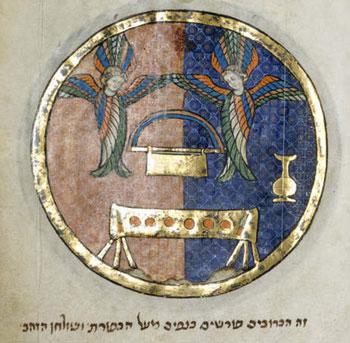
Solomon also decorated the walls of the Temple with cherubim in carved relief:
(כט) וְאֵת֩ כׇּל־קִיר֨וֹת הַבַּ֜יִת מֵסַ֣ב ׀ קָלַ֗ע פִּתּוּחֵי֙ מִקְלְעוֹת֙ כְּרוּבִ֣ים וְתִמֹרֹ֔ת וּפְטוּרֵ֖י צִצִּ֑ים מִלִּפְנִ֖ים וְלַחִיצֽוֹן׃
(29) All over the walls of the House, of both the inner area and the outer area, he carved reliefs of cherubim, palms, and calyxes,
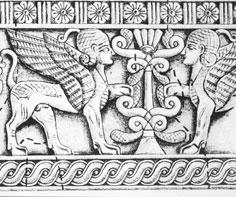
Cherubs and Palms, Palace of Ashurnasirpal II, Nimrud
The above drawing of an ivory plaque from Assyria shows just such an alternating pattern of the mythical creatures and the date palms, which probably represented the Tree of Life. As freestanding statues and relief carvings, the cherubim not only support the divine throne and power the divine chariot, but they are now ornaments throughout the Temple, and in the Holy of Holies, they are security guards, similar to the Assyrian lamassu , restricting access to the divine.
The cherubim, then, were been both hidden and viewed; in Solomon's temple, all three forms were unseen by any but priests. Subsequently cherubim virtually disappear from the Hebrew Bible being mentioned only once more (II Kings 19:15 = Isaiah 37:16), up until the time of Ezekiel.
However, from archaeology we know today that the cherubim were also found in the public domain; they were used as a decorative motif, especially in the ivory carvings found in the homes of the northern kingdom of Israel's wealthy class.

In addition, Jeroboam, the first king of Israel, employing forbidden images in the ritual of his new kingdom, established the cult of the golden calves at his holy sites in Bethel and Dan. These statues were analogous to the cherubim, in that both were conceived as transporting the invisible God. Evidence both in the Bible and from archaeology indicates that the calves were on public display, for example at the outdoor cultic site at Dan, where Jeroboam proclaims "These are you gods, Israel, who brought you up out of the land of Egypt" (II Kings 12: 28). Thus in Judah, the cherubim were sequestered in the Temple, lest the image be worshiped, while in northern Israel, the calves were open to viewing and available for adoration, evidence of controversy in ancient Israel regarding the presence of icons in worship.
Ezekiel and Beyond
The most detailed and elaborate description of the cherubim comes in the Book of Ezekiel, stemming from the period of the Babylonian Exile. In chapter 1, the prophet Ezekiel describes his vision of the Divine chariot (merkaba), a description that became one of the major bases of Jewish mysticism. While chapter 1 refers to the beings that transport the chariot simply as "creatures", the parallel description of the chariot in chapter 10 uses the term cherubim consistently. In chapter 1, the creatures have a partially human torso, two sets of wings, human hands and "straight legs" ending in calves' hooves.
(י) וּדְמ֣וּת פְּנֵיהֶם֮ פְּנֵ֣י אָדָם֒ וּפְנֵ֨י אַרְיֵ֤ה אֶל־הַיָּמִין֙ לְאַרְבַּעְתָּ֔ם וּפְנֵי־שׁ֥וֹר מֵהַשְּׂמֹ֖אול לְאַרְבַּעְתָּ֑ן וּפְנֵי־נֶ֖שֶׁר לְאַרְבַּעְתָּֽן׃
(10) Each of them had a human face [at the front]; each of the four had the face of a lion on the right; each of the four had the face of an ox on the left; and each of the four had the face of an eagle [at the back].
Where have we seen this hybrid before? Where had Ezekiel seen it? On the one hand, as a priest he had certainly been raised on tales of the cherubim on the Ark of the Covenant; on the other hand, living in the Babylonian exile, he probably saw images daily such as below:
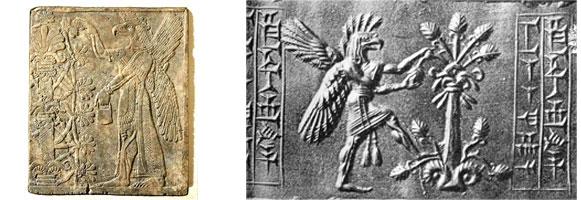
As opposed to the lamassu mentioned above, Ezekiel's cherubim, like these griffins or genii, have two-legged human torsos; on the other hand, Ezekiel's cherubim like the lamassu, have features of the same four animals: bird, ox, human and lion.
Why these four? Joseph Campbell, a renowned historian of religions, writes as follows:
The winged lion-bull with human head combines in one body those
four signs of the zodiac that in the earliest period of Mesopotamian
astronomy marked the solstices and equinoxes: the Bull (spring
equinox and eastern quarter), Lion (summer solstice and southern
quarter), Eagle (later Scorpio: autumn equinox and western quarter),
and Water carrier (winter solstice and northern quarter). These are
the four "living creatures" of Ezekiel's vision and of the apocalypse.
The Mythic Image, p. 285
The Tetramorph
This beast, representing human space and time, guarded the gates, access to the god-king, the Eternal One. In medieval Christian art, this composite beast comes apart into its four components, representing the four Evangelists—Matthew, Mark, Luke and John.
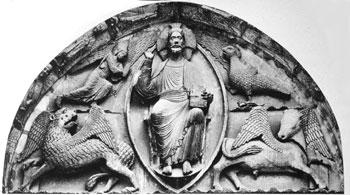
Cathedral of Chartres, Pantocrator
and Evangelists, 13th cent.
Each is identified with one of the four. Together they are called the Tetramorph. As in Mesopotamian astronomy, they represent human space and time. In Chartres, they flank the ellipse in which Jesus is enthroned.
Where is this pervasive Tetramorph in Jewish art?
In early Jewish art, fear of the Golden Calf and reservations regarding the human image prevent the full representation of the Tetramorph. Thus, in Bet Alpha, crude lions and "eagles" flank the Holy Ark. The idea is present but the imagery is suppressed. What is eternal is the Torah, not an image of God; Human space and time are naively present with cultic objects of the Temple.
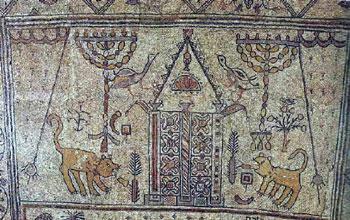
Bet Alpha Synagogue. The Holy Ark
In later Jewish art, the Tetramorph finally makes a modest appearance, as in this illustration from the 14th century Wroclaw Mahzor.
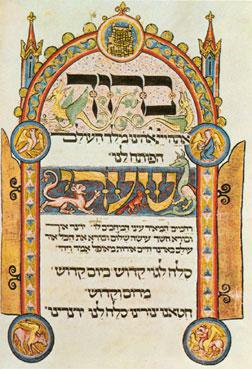
see page 180
Five medallions are affixed to a Romanesque gate, four of which enclose the "living creatures" (hayot), represented by an eagle, a man, an eagle and an ox. The fifth medallion, placed uppermost in the arch, shows the empty throne of the Eternal One.
We have followed the life of the cherubim for over 3000 years and seen their protean transformation, which was enabled by their multiple identity and their profound symbolism, the human yearning to see the divine and the concomitant fear of that mysterious encounter.
One strange result of this pull in two contradictory directions is the common use of the word cherub, as round faced baby angels, as far as can be imagined from the fearsome hybrid creatures of ancient times.
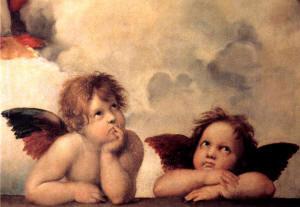
And finally, a modern visual midrash on the cherubim.
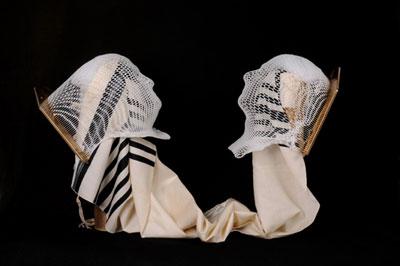
Jo Milgrom, Cherubim looking up
"These are not Rafael's cherubic fat- pulked toddlers.
My cherubim are exotic beings metamorphosed into
contemporary art but still retaining their original association
with the divine, in this case as a prayer for healing. Their heads
are wrapped in prayer shawls. Their faces are fitted and marked
with the individual mask for radiation treatment. They look
upward 'from whence cometh my help'. They belong to Jacob
Milgrom's spirit."
For additional images on this subject see TALI Visual Midrash



